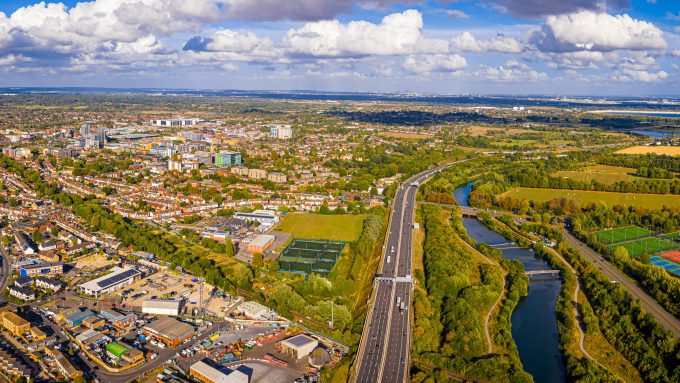
Digital Environmental Impact Assessments: Cutting the Gordian Knot

Environmental Impact Assessments (EIAs) are a crucial part of the design evolution and approval process for major projects. Regulated by EU/UK legislation, its purpose is to ensure the environmental and social effects of proposals are understood prior to decision making.
However, currently, the process is seen as a heavy administrative burden to the parties involved, with the outputs of EIAs – an environmental statement (ES) – printed in A4 ring binders and delivered in boxes to local authorities. These are often criticised for being full of technical jargon, impenetrable language, and difficult to navigate and read.
So far, EIAs have not harnessed current digital technology to drive productivity (ie, making the process more efficient, integrated, transparent and collaborative) for environmental protection (delivering greater measurement, monitoring and management of environmental impacts).
That’s where we come in: Connected Places Catapult, Quod, Temple Group, Liquorice and ODI Leeds, as part of a consortium, have received funding from Innovate UK to explore how a better designed, data-informed and digitally delivered EIA process might be beneficial for developers, planners and members of the public. We’ve been listening to users and stakeholders in developing and testing ideas and opportunities to use digital technology to fundamentally transform today’s EIA process.
Environmental Impact Assessment: the challenges
We learned that today’s EIA is characterised by a messy web of diverse stakeholders, ie, planners, environmental experts, developers, regulators, coordinators etc, working across the process. This way of creating and developing an EIA is quite complex, but more importantly, there are a lot of missing links, as well as risk for detail or nuance to be lost. Today’s process creates many barriers to engagement and collaboration across and between stakeholders (especially with local communities) leading to eroded relationships and trust.
EIAs are also characterised by their massive size: if you combine a tendency for ‘over‘-scoping’, risk-aversive culture, reliance on generalistic single use-case and over-modelling, you end up with an ‘obesity crisis’. This means there is a disproportionate production of data, analysis and information contained within the ES reports. This, with its emblematic technical jargon, contributes to their impenetrability and makes it difficult for non-technical stakeholders and local communities to understand and engage. Additionally, while publicly available once submitted, the data contained within these reports are neither standardised nor machine-readable.
Furthermore, we are also constantly reproducing the data instead of sharing and recycling it. When the data has been processed, analysed and transformed into graphics and communicated in PDFs, it is subsequently stored within the hard-drives of specialist consultants, never to be reused again. We are currently archiving useful information that could instead be recycled or sold across projects and for other purposes.
Finally, despite all the time and money spent on predicting the impact of a development, there is a lack of monitoring once the development is completed. This would verify whether the initial predictions were correct and if the proposed mitigation was successful. If utilised in a forward-looking manner, the effectiveness of measures can be assessed and reviewed for future schemes, potentially leading to benefits for both the developers and other affected parties.
So what does the industry need to do to address these challenges?
Overall, the EIA system needs a wholesale digital transformation, founded on better data, data-sharing and more collaborative tools. Piecemeal change focused only on small components will only bring short-term solutions, small scale efficiencies and minor increases in accessibility. As part of our research, we’ve identified several key areas for transformation:
- First, the process needs to systematically collect, feed, store and access data in a standardised machine-readable format, to allow recouping and recycling within and across assessments.
- EIA also needs to be streamlined, where previous stages inform and build subsequent ones, eg the scoping process should automatically generate the EIA chapters template.
- A digital EIA should allow multiple stakeholders to write, collate, model, and assess impacts simultaneously, while managing, visualising and tracking overall progression.
- The environmental statement needs to explore new technologies and visualisation to communicate the impacts in an accessible, interactive, transparent and personalised way.
- And finally, the whole assessment needs to be reviewed by post-development monitoring to re-configure mitigation, environmental baseline and re-assess methodologies.
Technically, this could be done in numerous ways, but a good way to begin would be with an EIA National Datastore. This infrastructure would underpin all of the solutions we have identified and form the core of a digital EIA. This EIA datastore could either incorporate a centralised or distributed approach that allows all raw EIA data (national, local and site-specific field data) to be accessed, stored and uploaded in a standardised way.
What comes next?
Our user research and technology review identified the need for wholesale digital transformation. We are currently finalising three core prototypes, alongside recommendations for policy and legislation change, and a roadmap for open innovation to finance and deliver an operational digital EIA platform.
Today, as we approach the end of the discovery phase, we are ready to present to you the cumulation of all this work. We’re going to be showcasing our findings at our digital EIA launch event on the 24 March 2020. We’ll be using this piece of discovery to steer the conversation around the changes needed in our current system and how we can start overcoming the barriers and obstacles ahead of us.
Author: Sebastien Herman, Junior Urbanist, CPC





